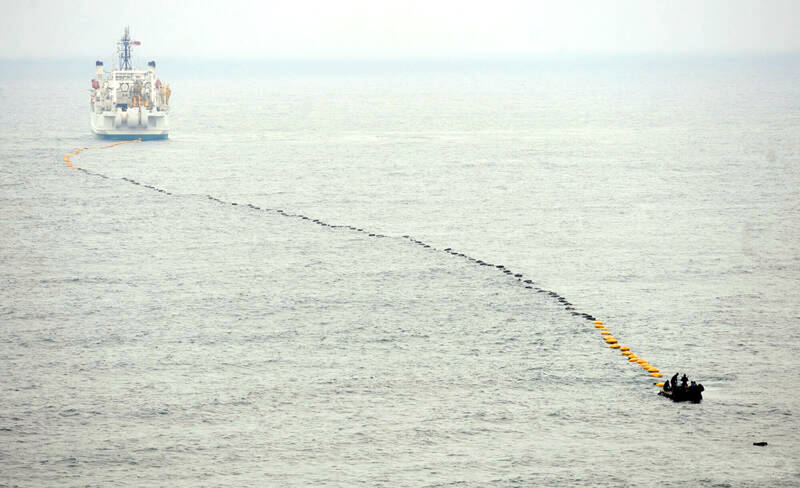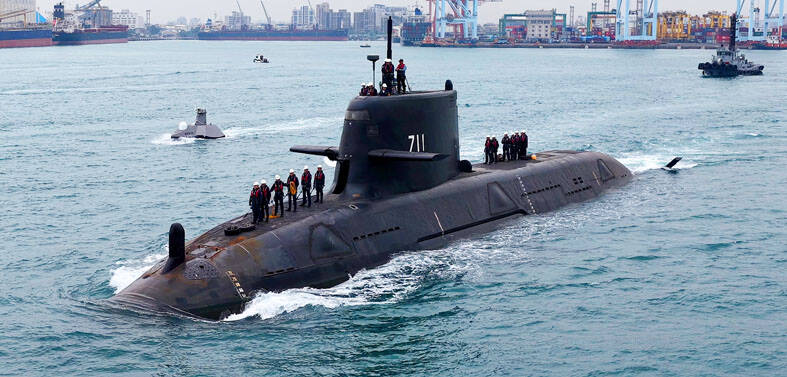Officials yesterday vowed to enhance patrols in key offshore areas in response to the cutting of an undersea Internet cable last week by the Cameroon-registered, Hong Kong-owned freighter Shunxing-39 (順興39號), while Keelung prosecutors said they have opened an judicial investigation into the incident.
Cabinet spokeswoman Michelle Lee (李慧芝) yesterday said the Coast Guard Administration (CGA) has gathered data about the incident, including the course taken by Shunxing-39, and given it to the Keelung District Prosecutors’ Office.
“The CGA has recorded all of Taiwan’s undersea cables, their landing points onshore and the respective offshore areas, to compile onto marine maps. These are the priority sectors for marine patrol and surveillance by CGA vessels,” Lee said at a news conference following the Cabinet meeting.

Photo: Taipei Times
“In case of a future similar incident of ships undertaking suspicious activities and causing damage to undersea cables, we shall take the same measures — gathering evidence and marine tracking data, and prosecuting those found responsible,” she added
The Mainland Affairs Council (MAC) at a separate news conference said that it cannot rule out the severing of the Trans-Pacific Express cable as being part of China’s “gray zone” tactics.
“China has caused problems around the world, with Chinese ships registered abroad and flying other countries’ flags suspected of deliberately cutting undersea cables. Last year, they damaged cables in the Baltic Sea, prompting an investigation by Sweden, Finland and other nearby countries,” MAC Deputy Minister and spokesperson Liang Wen-chieh (梁文傑) said.
“Taiwan also had to deal with numerous incidents of undersea cables being cut in waters around Kinmen and Lienchiang counties. Our government has to take a serious stance regarding these situations,” Liang said.
A formal request for assistance was also sent to South Korea, as heavy seas had prevented coast guard personnel from boarding the Shunxing-39 last week, which has since set course to Busan.
The MAC said it was a Chinese vessel owned by Jie Yang Trading Ltd, a Hong Kong company headed by Chinese citizen Guo Wenjie, has seven Chinese crewmembers, and is registered as Shunxing-39 in Cameroon and Xingshun-39 in Tanzania.
Guo denied the ship’s involvement in the cutting of the cables, but confirmed it had been in the area.
“There is no evidence at all,” he said. “I spoke to the ship captain and for us, it was a normal trip.”
Hong Kong’s records showed the company had been set up in 2020, with Guo as the sole director. Its listed address was a single room in a cosharing office space for a secretarial services company in an industrial building.
China’s Taiwan Affairs Office in a written statement on Wednesday said, globally, there were more than 100 incidents of damage to undersea cables annually, and that they are “common maritime accidents.”
With the facts still unclear, Taiwan is making accusations “out of thin air” and intentionally hyping up the “so-called ‘gray zone’ threat from the mainland,” it added.
The CGA said it was not yet able to gauge the ship’s “real intention.”
The vessel had lingered in waters off northern Taiwan since early last month until its signal was turned off on Friday last week, data showed.
Guo declined to specify why the ship had remained in the area or the purpose of the voyage, but said authorities had only sought details of its GPS movements.
“I don’t understand why there has been so much news about this. The ship had dropped anchor, so it had stopped in the nearby waters,” he said. “We followed the rules and normal procedures. If not, then Taiwan would have investigated and detained us.”
Additional reporting by Reuters

US climber Alex Honnold is to attempt to scale Taipei 101 without a rope and harness in a live Netflix special on Jan. 24, the streaming platform announced on Wednesday. Accounting for the time difference, the two-hour broadcast of Honnold’s climb, called Skyscraper Live, is to air on Jan. 23 in the US, Netflix said in a statement. Honnold, 40, was the first person ever to free solo climb the 900m El Capitan rock formation in Yosemite National Park — a feat that was recorded and later made into the 2018 documentary film Free Solo. Netflix previewed Skyscraper Live in October, after videos

NUMBERS IMBALANCE: More than 4 million Taiwanese have visited China this year, while only about half a million Chinese have visited here Beijing has yet to respond to Taiwan’s requests for negotiation over matters related to the recovery of cross-strait tourism, the Tourism Administration said yesterday. Taiwan’s tourism authority issued the statement after Chinese-language daily the China Times reported yesterday that the government’s policy of banning group tours to China does not stop Taiwanese from visiting the country. As of October, more than 4.2 million had traveled to China this year, exceeding last year. Beijing estimated the number of Taiwanese tourists in China could reach 4.5 million this year. By contrast, only 500,000 Chinese tourists are expected in Taiwan, the report said. The report

Temperatures are forecast to drop steadily as a continental cold air mass moves across Taiwan, with some areas also likely to see heavy rainfall, the Central Weather Administration (CWA) said. From today through early tomorrow, a cold air mass would keep temperatures low across central and northern Taiwan, and the eastern half of Taiwan proper, with isolated brief showers forecast along Keelung’s north coast, Taipei and New Taipei City’s mountainous areas and eastern Taiwan, it said. Lows of 11°C to 15°C are forecast in central and northern Taiwan, Yilan County, and the outlying Kinmen and Lienchiang (Matsu) counties, and 14°C to 17°C

STEERING FAILURE: The first boat of its class is experiencing teething issues as it readies for acceptance by the navy, according to a recent story about rudder failure The Hai Kun (海鯤), the nation’s first locally built submarine, allegedly suffered a total failure of stern hydraulic systems during the second round of sea acceptance trials on June 26, and sailors were forced to manually operate the X-rudder to turn the submarine and return to port, news Web site Mirror Daily reported yesterday. The report said that tugboats following the Hai Kun assisted the submarine in avoiding collisions with other ships due to the X-rudder malfunctioning. At the time of the report, the submarine had completed its trials and was scheduled to begin diving and surfacing tests in shallow areas. The X-rudder,